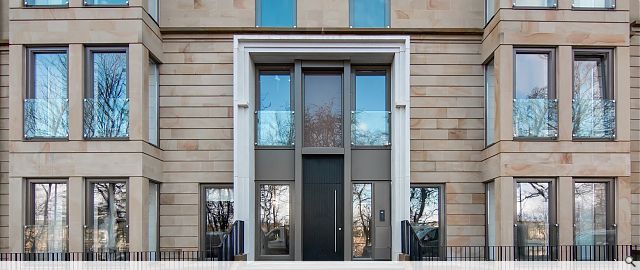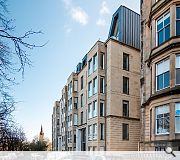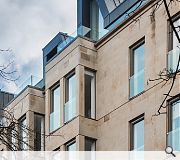Park Quadrant
Holmes Miller’s initial involvement in Park Quadrant began in December 2014, when the development site was brought to the open market by Glasgow City Council via City Property. This was not the first time it had been the focus of potential development. Having been compulsory purchased back in the early 1980s, there were several previous attempts to develop it over the years, all of which were unsuccessful for one reason or another.
The ‘missing link’, the ‘final piece in the jigsaw’; a site forming part of Charles Wilson’s magnificent 1850 concentric ringed Park Area masterplan, which many weren’t even aware had never been completed.
The Park Area for over a century has been the focal point and a symbol of the importance of Glasgow within the Victorian period, where the wealth of Atlantic and World-Wide trade was fully on show. The crowning glory of the West End, located on high around Kelvingrove Park, it was a celebration of form and the current architectural styles of the period. A period of unparalleled construction which was, in the case of Park Quadrant, sadly cut short due to financial crisis.
Over the subsequent decades and eventually more than a century and a half, the masterplan remained incomplete, with the site being temporarily used as a pleasure garden, then school grounds, and latterly being disused, overgrown, and unloved.
Given the importance of the site historically, there was a strong emphasis on relationship to context, materiality and historic reference within the City Council’s development brief. Whilst it would be over simplistic to say the site effectively designed itself, there was certainly a clear set of easily understood visual design cues and controls. Our approach was to use these as a kit of parts, which assured the quality of the finished product. These controlling elements allowed us to remain flexible in response to commercial, design, and Planning constraints throughout the early design development stage, and enabled us to deliver 98 contemporary luxury apartments seamlessly within a sensitive historic context.
Design metrics such as plot width, apartment area, plan depth, ceiling heights, orientation and aspect were continuously tested against these rules in order to achieve the optimum arrangement and maximise value within these constraints. The approach to the elevation treatment was to respect, but not copy the existing buildings. The design should be contemporary, confident, but also respectful and quiet. Design solutions for parking and amenity space were also a challenge given the tight site and the requirements for off-street parking for newbuild development. This particular aspect was resolved using the site topography and effectively sinking the parking below a communal landscaped garden running the full length of the site.
A project of this level of importance, within one of the key Conservation Areas within The City, brings with it a myriad of exciting challenges, along with intense scrutiny, debate, resistance and of course differences of opinion. It was clear that local interest in the proposals would be a major factor, and it was also clear from early on that not everyone shared the same aspirations for the site’s future.
Our involvement through the early stages of the Planning process included a number of critical consultation exercises, with Urban Design Panels, Heritage groups, local residents and Community Councils. These have proven to be a valuable learning experience, and have had a positive impact on the evolution of the design. Often challenging, key issues were addressed head-on by clearly focusing on the importance of the original masterplan and how our design was first and foremost part of an overall composition including all other surrounding buildings.
PROJECT:
Park Quadrant
LOCATION:
Park Circus, Glasgow
CLIENT:
Ambassador Group
ARCHITECT:
Holmes Miller
Back to Housing
Browse by Category
Building Archive
- Buildings Archive 2024
- Buildings Archive 2023
- Buildings Archive 2022
- Buildings Archive 2021
- Buildings Archive 2020
- Buildings Archive 2019
- Buildings Archive 2018
- Buildings Archive 2017
- Buildings Archive 2016
- Buildings Archive 2015
- Buildings Archive 2014
- Buildings Archive 2013
- Buildings Archive 2012
- Buildings Archive 2011
- Buildings Archive 2010
- Buildings Archive 2009
- Buildings Archive 2008
- Buildings Archive 2007
- Buildings Archive 2006
Submit
Search
Features & Reports
For more information from the industry visit our Features & Reports section.





